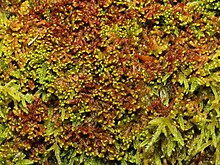Ptilidiaceae
| Ptilidium | |
|---|---|
 |
|
| Ptilidium pulcherrimum | |
| Scientific classification | |
| Kingdom: | Plantae |
| Division: | Marchantiophyta |
| Class: | Jungermanniopsida |
| Order: | Jungermanniales |
| Family: |
Ptilidiaceae H. Klinggr., 1858 |
| Genus: |
Ptilidium Nees, 1833 |
| Species | |
|
Ptilidium californicum |
|
Ptilidium californicum
Ptilidium ciliare
Ptilidium pulcherrimum
Ptilidium is a genus of liverwort, and is the only genus in family Ptilidiaceae. It includes only three species:Ptilidium californicum, Ptilidium ciliare, and Ptilidium pulcherrimum. The genus is distributed throughout the arctic and subarctic, with disjunct populations in New Zealand and Tierra del Fuego. Molecular analysis suggests that the genus has few close relatives and diverged from other leafy liverworts early in their evolution.
The name of the genus comes from the Greek word ptilidion for "small feather", in reference to the multiply deeply divided leaves with fringed edges, which give the plant a "feathery" appearance. Unlike other leafy liverworts, the underleaves are not significantly smaller than the lateral leaves. The "flossy" appearance from the leaf edges, together with the characteristic yellowish-brown or reddish-brown color make the genus easy to recognize.
Like Ptilidium, Blepharostoma and Trichocolea have deeply divided leaves with marginal cilia, however Ptilidium differs from these other two genera in that its leaf cells have bulging trigones (thickenings at the corners between cell walls).
The plants grow in dense mats, with stems growing either prostrate or ascending. Individual stems are once or twice pinnate, rarely with branches and only a few short rhizoids. The leaves are incubous and divided deeply into three to five portions, and edges of the leaf divisions are fringed with cilia. The underleaves are similar to the lateral leaves, but are slightly smaller. All species are dioicous, producing antheridia and archegonia on separate plants. The archegonia are terminal on a main stem. Mature sporophytes develop from within a large perianth with three distal folds.
...
Wikipedia
